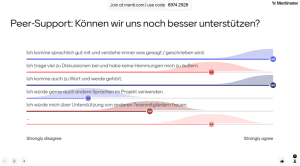4. Summary
This online module has touched on the essential components that need to be taken into consideration when designing a meaningful and effective VE. Its goal was to equip you with the knowledge about these components and provide you with examples and some guiding questions that will help you plan your own VE. The role of teachers and students in a VE highlights the collaborative nature of a VE. Teachers are not only facilitators but also co-learners, and students are taking on active roles in their learning by representing local experts, which emphasizes the impact of these roles on VE activities and assessments.

The module discusses the importance of identifying a well-defined purpose for your VE as a crucial step early in the planning phase, setting the stage for writing up learning outcomes as well as long-term outcomes that contribute to students’ development beyond the VE. Learning outcomes and the importance of their clear articulation, especially when discussing them with your potential VE partners during the planning phase, take up a main focus in this module. Sharing the graduate attributes and global competence skills that you wish your students to develop will help you set clear goals that your projects and activities will help reach. On a lesson plan level, where you and your partners plan specific activities and projects that foster graduate attributes and global competence skills, this module reminds you to consider various factors pertaining to technology and the diverse student body.
While this module presents these components in a specific order, keep in mind that planning a VE is an iterative process, where insights from each phase or step inform and enhance others. The type of VE will help narrow down the purpose and goals of your VE, and the roles of teachers and students impacts the identification of content and learning outcomes. Similarly, the digital tools you plan to implement need to align with the activities and the overall curriculum and assessments.
References
Biggs, J. (1996). Enhancing teaching through constructive alignment. Higher education, 32(3), 347-364.
Boud, D., & Solomon, N. (2006). Work-Based Learning, Graduate Attributes and Lifelong Learning. In: Hager, P., Holland, S. (eds) Graduate Attributes, Learning and Employability. Lifelong Learning Book Series, vol 6. Springer, Dordrecht.
Crozet, C., & Liddicoat, A. J. (1999). The challenge of intercultural language teaching: Engaging with culture in the classroom. Striving for the third place: Intercultural competence through language education, 113-125.
Deardorff, D. K. (2022). Assessing intercultural learning outcomes in COIL courses. In Implementing Sustainable Change in Higher Education (pp. 287-297). Routledge.
Guth, S., Helm, F. (2010). Telecollaboration 2.0. Language, Literacies and Intercultural Learning in the 21 st Century. Lausanne, Schweiz: Peter Lang Verlag.
Helm, F. (2025). Intercultural Communication in Virtual Exchange. Elements in Intercultural Communication.
Innes, J. E. (1995). Planning theory’s emerging paradigm: Communicative action and interactive practice. Journal of planning education and research, 14(3), 183-189.
Leask, B. (2009). Using formal and informal curricula to improve interactions between home and international students. Journal of studies in international education, 13(2), 205-221.
Leask, B. (2015). Internationalizing the curriculum. Routledge.
Liddicoat, A. (2004). Intercultural language teaching: Principles for practice (Doctoral dissertation, New Zealand Association of Language Teachers).
O’Dowd, R. (2018). From telecollaboration to virtual exchange: State-of-the-art and the role of UNICollaboration in moving forward. Research-publishing. net, 1, 1-23.
O’Dowd, R., & Dooly, M. (2020). Intercultural communicative competence development through telecollaboration and virtual exchange. In The Routledge handbook of language and intercultural communication (pp. 361-375). Routledge.
O’Dowd, R. (2022). Internationalising higher education and the role of virtual exchange. Routledge.
Rubin, J. (2017). Embedding collaborative online international learning (COIL) at higher education institutions. Internationalisation of Higher Education, 2, 27-44.
Rubin, J. (2022). Developing Coil Infrastructure and Forming a Core Team: Initial Steps. In Implementing Sustainable Change in Higher Education (pp. 98-110). Routledge.
SGCL Swiss Global Competence Lab (2024a). Developing a global competence certificate in Switzerland.
SGCL Swiss Global Competence Lab (2024b). Virtual Exchange and its role in Global Competence Development. An abbreviated guide for successful virtual exchange projects.
Studer, P., Bürki, J., & McGury, S. (2024). Implementing global competences in higher education in Switzerland: conceptual considerations.
Toohey, S. (1999). Designing courses for higher education. McGraw-Hill Education.
Vercellotti, M. L. (2018). Do interactive learning spaces increase student achievement? A comparison of classroom context. Active Learning in Higher Education, 19(3), 197-210.
Wiggins, G., & McTighe, J. (2005). Understanding by design (2e). Alexandria, VA: Association for Supervision and Curriculum Development (ASCD).
All illustrations on this page by @storyset (https://www.freepik.com/author/stories)
This work © 2025 by Sandra McGury is licensed under CC BY-NC-ND 4.0
